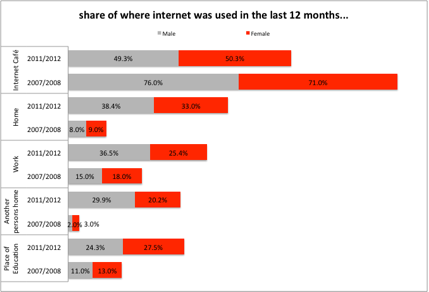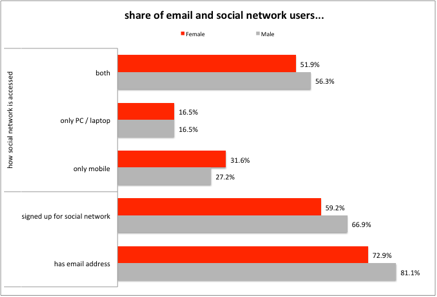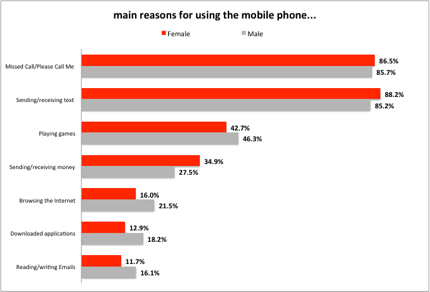Accessing telecommunications infrastructure in Africa: A gender perspective
| Attachment | Veličina |
|---|---|
| Access: A gender perspective | 1.03 MB |
Organization
Introduction
Despite the rhetorical undertaking of governments and multilateral agencies, there has been little systematic collection of sex-disaggregated data on information and communications technology (ICT) access and use. [1]
A newly released study by Research ICT Africa (RIA) provides a sex-disaggregated overview of ICT access and use across 11 African countries which highlights the unevenness of access to ICTs. The study unmasks the gender dimensions of the limited sex-disaggregated ICT indicators available. Using the RIA 2012 survey data[2] and building on the 2010 RIA gender and ICT report,[3] it assesses the gap in ICT access and use from a gender perspective and examines whether the gap between men and women exists. RIA also surveyed how women entrepreneurs in the informal sector make use of ICTs – mainly mobile phones and the internet – to conduct daily business activities.
Though in general, access to and use of mobile phones and the internet among women have increased, the RIA study confirms the findings of the few systematic national and multinational studies in this area that women and men are not equally able to access and use ICTs. It goes further to demonstrate that this increases as the technologies and services become more sophisticated and expensive, requiring greater levels of income and education to access and to operate. Modelling of the nationally representative survey data, however, demonstrates that this inequality is not a result of anything inherent in ICTs, but rather a result of women being more concentrated in lower income groups, in lower education levels and in rural areas, or more generally what has become referred to as the “base of the pyramid”.
Women and technology
Mobile ownership
The uptake of mobile technology in Africa in general has increased significantly in the last three years. The breakdown by gender of mobile phone ownership shows that since the 2008 RIA survey, it has increased significantly for both sexes, as shown in Figure 1. However, the 2012 data shows that a gender gap still persists. Mobile ownership among females increased in all countries over the two periods observed, in particular in Botswana (23.8%), Uganda (22.3%) and Kenya (21%). In fact, the adoption of mobile phones among women exceeds that of men in Botswana in particular, and also in Namibia and Cameroon, though by a lesser extent. However, in all the other countries surveyed, the share of men that own a mobile phone continues to be higher in comparison to women.

Figure 1: Mobile ownership compared by gender across countries
(Note: Nigeria data in 2008 was based on estimation) Source: RIA Data 2012
Mobile phones have become the new tool for accessing the internet[4] and the share of individuals with internet-enabled mobile phones is growing. But in most of the countries, except in Tanzania and Rwanda, women still lag behind in terms of owning internet-enabled mobile phones (see Figure 2).

Figure 2: Share of individuals with mobile phones capable of browsing the internet Source: RIA Data 2012
Internet access
Though it is said that access to and use of the internet can boost women’s income and increase their sense of empowerment and equity, there are still some women who are not aware of the internet and its benefits, and others who simply do not have the know-how or technical skills. Despite the increase in internet use in recent years, there are still over four billion of the world’s population that do not have access, the majority of whom are women. [5]
In general, the adoption of internet use in Africa has been rather slow, mainly as a result of limited connectivity across many countries and the very high cost of services where they are available. Internet use in all countries in general and by gender increased between 2008 and 2012 (see Figure 3). However, in almost all the countries, except in Cameroon and Tanzania, there are more men using the internet than women. The increase in the share of female internet users between the two periods was more pronounced in Botswana, where the figure increased by 22.5%. The increase was, however, comparatively low in Rwanda (3.1%), Uganda (2.0%), Cameroon (1.9%), Tanzania (1.2%) and Ethiopia (0.7%).

Figure 3: Share of individuals 15 years or older using the internet by gender (16+ for 2008) Source: RIA Data 2012
Though access from an internet café still remains predominant, this figure has dropped, with access shifting more towards use from home, work, place of education and another person’s home. The share of women accessing the internet from an internet café dropped by about 21%. Women accessing the internet from home increased by 24%, while those accessing it from another person’s home increased by 17.2%. The share of women also making use of the internet from an academic institution went up from 13.0% to 27.5% in 2012 (see Figure 4). Also notable, though not included in the figure below, is the share of individuals that accessed the internet through their mobile phones. About 74% of men and 71% of women used the internet on their mobile phones during the last 12 months (RIA 2012). This, as well as the availability of internet modems, could be a contributing factor to the shift from accessing the internet via a public place (internet café).

Figure 4: Share of where internet was used in the last 12 months Source: RIA Data 2012
The use of social networks has been one of the contributing factors to the recent increase in internet use, and more individuals are increasingly accessing social network sites through their mobile phones. The share of women accessing social networks from mobile phones (31.6%) is higher than men (27.2%) and this could possibly be due to their low levels of e‑skills, which limit their use of computers. However, the share of males signed up for social networks is still higher (see Figure 5).

Figure 5: Share of individuals using email and accessing social networks Source: RIA Data 2012
Affordability and use
On average, women are shown to spend less than men on mobile phone use, except in Ethiopia, Rwanda and Tanzania. This could be due to their lower earning capacity, which constrains how much they can allocate to mobile use and in turn limits the way they make use of their mobile phones (see Figure 6).

Figure 6: Monthly expenditure on mobile phone in USD PPP Source: RIA Data 2012
Though there are differences in which activities more women use their mobile phones for than men, these differences are only slight (see Figure 7). The results show that some of the more advanced and sophisticated activities, such as downloading applications, browsing, games and email, are more common among men, while the more basic (missed call/please call me, text messaging, sending/receiving money) are used more by women. This could be due to underlying factors such as skills or education and income, which in turn affect affordability, as the relatively more advanced uses of mobile phones usually require more data and better skills.

Figure 7: Main reasons why individuals use mobile phones Source: RIA Data 2012
Women mostly claim that they do not own a mobile phone because they “cannot afford one” or they “have no one to call” or their “phone is broken”. About 7.8% more women stated that they do not use the internet because they “do not know what it is” and about 4% more stated they “do not know how to use it”. Slightly more women also mentioned that they do not use the internet because it is too expensive (see Figure 8). These reasons are indicative of the exclusion factors, namely education (knowledge/skills) and income (affordability).

Figure 8: Main reasons why individuals do not use the internet Source: RIA Data 2012
Empirical findings
Using logistic regression models to further analyse the gender divide in mobile ownership and internet use indicates that in general, when income and education are controlled for, there is a negative relationship between the gender variable and both mobile ownership and internet use. The relationship is not statistically significant in the case of mobile ownership, indicating only a negative correlation between mobile adoption and being female. However, the relationship is statistically significant in the case of internet use, showing a negative causal relationship between being female and using the internet.
Income and education show a positive relationship to mobile adoption and internet use, an indication that with more income and higher levels of education, the probability of an individual owning a mobile phone or using the internet is increased. This relationship is also maintained across all countries and supports the findings by Gillwald et al. in a 2010 study. [6]
Women in the informal sector
The structural constraints faced by women in terms of education, income, assets and limited access to financial resources have pushed most of them into the informal sector, a sector which is said to have become a domain for the marginalised, unemployed and poor.[7] The theory developed by the Global Entrepreneurship Monitor stated that people in developing countries were driven by poverty, survival and a lack of choice to start business ventures, concluding that the greater the poverty, the higher the level of necessity entrepreneurship in a country.
Sex-disaggregated data of the motivating factors for starting a business shows that the majority of female respondents had been “pushed” into entrepreneurship across all countries except Kenya, where slightly more women were “pulled” into entrepreneurship. This indicates that those who go into business in the informal sector as a way of making a living and finding some form of employment are mostly women.[8]
Gender and the use of ICTs for business
Mobile phones are found to be the only widely used ICT amongst informal businesses.[9] However, a lower share of female entrepreneurs use mobile phones for business purposes. The gender inequalities are more pronounced in Ethiopia, where 46.4% of male-owned businesses used mobile phones for business purposes in comparison to 3.2% of female-owned businesses. The mobile phone is the tool most widely used to communicate with suppliers and customers, yet with the exception of Uganda, female-owned businesses still lag behind their male counterparts in the use of mobile phones to communicate with suppliers, with a significant difference between male entrepreneurs (36.4%) and female entrepreneurs (2.4%) in Ethiopia. Similar trends were found with fewer female entrepreneurs using this medium to communicate with customers in all countries except Kenya (see Table 1).
|
Table 1: Informal businesses with mobile phones and internet access |
||||||
|
|
Using mobile phones for business purposes
|
Working internet connection |
||||
|
|
National |
Male owner |
Female owner |
National |
Male owner |
Female owner |
|
Botswana |
42.3% |
45.4% |
36.8% |
2.9% |
3.6% |
2.0% |
|
Cameroon |
56.2% |
68.0% |
40.9% |
2.2% |
2.0% |
0.0% |
|
Ethiopia |
12.3% |
46.4% |
3.2% |
0.0% |
0.3% |
0.0% |
|
Ghana |
44.9% |
57.3% |
35.7% |
0.7% |
1.2% |
0.2% |
|
Kenya |
67.4% |
70.3% |
62% |
3.0% |
6.2% |
1.2% |
|
Namibia |
51.9% |
60.5% |
45.3% |
2.2% |
3.9% |
0.9% |
|
Nigeria |
44.2% |
57.3% |
37.2% |
0.1% |
0.3% |
0.0% |
|
Rwanda |
53.4% |
54.5% |
44.9% |
0.7% |
0.5% |
0.3% |
|
South Africa |
49.5% |
55.0% |
38.3% |
10.5% |
7.5% |
7.8% |
|
Tanzania |
44.4% |
46.6% |
39.8% |
0.1% |
0.0% |
0.2% |
|
Uganda |
67.9% |
68.9% |
63.9% |
2.0% |
1.4% |
3.2% |
Source: RIA Data 2012
Internet use amongst informal businesses in all countries surveyed was negligible, though in South Africa and Uganda, there were slightly more female-owned businesses with a working internet connection.
Female entrepreneurs mainly claimed that they did not make use of mobile phones for business purposes as they were not relevant and they found no need for them. Significant gender differences were found in Ethiopia, where 47.8% of female business owners compared to 28.7% of male owners stated that they had no need for mobile phones, and in South Africa, where 55.1% of women entrepreneurs compared to 35.6% of men made the same claim. High costs, lack of need and unavailability of internet services are the main reasons why businesses do not make use of internet facilities to conduct their activities. The nature of businesses also plays a role in the communication devices that entrepreneurs opt for, and generally they opt for ICTs from which they will derive the highest benefit at the lowest cost.
Conclusions and recommendations
The sex-disaggregated overview in this study indicates that women and men do not access and use ICTs equally. Women generally have less access to ICTs and use them sub-optimally, and this increases as the technologies and services become more sophisticated and expensive.
The analysis shows that on average, women earn comparatively less than men. In general, fewer women than men have tertiary education, and even in the secondary and primary levels, the majority of the countries have fewer women completing these levels, emphasising the continued gender gap in education. These findings indicate that it is mainly this underlying gender gap in income and education that contributes to the exclusion of women in the ICT domain. This gap is reflected in the higher share of female entrepreneurs who were pushed into the informal sector to make a living and has further influenced the differences between male and female entrepreneurs in terms of access and use of ICTs for business purposes.
While the descriptive analysis shows that mobile phone and internet access have increased among women, modelling of the data indicates that there is a negative correlation between mobile adoption and being female and a negative causal relationship between using the internet and being female.
This evidence shows that to a large extent, gender inequities in access to and use of ICTs cannot be addressed through ICT policies per se, but require policy interventions in other areas that would allow women and girls to enjoy the benefits of ICTs equally. This would include policies and programmes that incentivise the education of girls, which in turn will increase the income that women have to spend on ICT services. Partnerships could be created to provide vocational and ICT skills training for women entrepreneurs to address the educational gap and increase their earning potential.
References
[1] As the final component of the WSIS Measuring the Information Society project undertaken by UNCTAD and ITU, standardised universal indicators for ICT access and use are being formulated.
[2] The methodology of the survey and the data can be found on RIA’s website: www.researchICTafrica.net
[3] For the full report by Gillwald, Milek and Stork (2010) see www.researchICTafrica.net
[4] Stork, C., Calandro, E. and Gillwald, A. (2013) Internet going mobile: Internet access and use in 11 African countries, Info, 15(5).
[5] Intel and Dalberg (2013) Women and the Web: Bridging the internet gap and creating new global opportunities in low and middle-income countries.
[6] Gillwald, A., Milek, A. and Stork, C. (2010) Gender Assessment of ICT Access and Usage in Africa, Volume 1, Policy Paper 5, RIA. www.researchictafrica.net/publications.php
[7] Flodman Becker, K. (2004) The Informal Economy: Fact finding study, Sida. rru.worldbank.org/Documents/PapersLinks/Sida.pdf
[8] RIA Data 2012.
[9] Deen-Swarray, M., Moyo, M. and Stork, C. (2013) ICT access and usage among informal businesses in Africa, Info, 15(5).